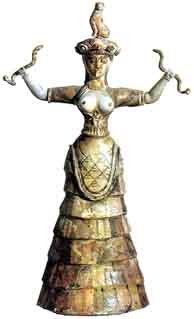Women in the Aegean
Minoan Snake Goddess
Christopher L. C. E. Witcombe
7. Fertility Deity?
Having identified the "Snake Goddess" as a "fertility deity" associated with the Mother Goddess most archaeologists and art historians seem content to leave it at that, as if the term "fertility deity" somehow explains the meaning of the figurine.
It is unfortunately too often the case that almost every nude or semi-nude image of a female belonging to the prehistoric period is interpreted as a "fertility" figure. Moreover, the idea of fertility which the figure represents or is associated with is usually the fertility of the land, the growth of crops, or less frequently of animals. On Minoan Crete, a fertility deity would presumably be invoked to ensure abundant crops, or the plentiful production of lambs and kids among the herds of sheep and goats.
The "Venus" of Willendorf [see The Venus of Willendorf] is also commonly identified as a "fertility" figurine, though she is different in almost every respect from the "Snake Goddess". These images are regarded not so much as representations of women per se but as allegorical figures or personifications of the idea or concept of fertility. The woman herself is unimportant; it is what she represents that is significant. And, although women also benefit from a land kept fertile, the fertility deity is there to serve first the needs of men. Consequently, it has generally been assumed that the "Snake Goddess" existed primarily in a male context.
To identify the "Snake Goddess" as a fertility deity is to impose upon it an interpretation that is so broad as to be virtually meaningless. At the same time it also effectively stifles consideration of it having a more specific meaning and functioning in a more specific and possibly non-male context. It is a general patriarchal bias to perceive the world and all that is in it from a male point of view. This view tends to eliminate any thought of the possibility that a demonstrably female figurine such as the "Snake Goddess" might have been made specifically for and have had particular meaning for women.
Once the possibility is raised, however, almost immediately there springs up around the figurine evidence to support an interpretation of the "Snake Goddess" as serving a particular role in connection with women.
8. SNAKES, EGYPT, MAGIC, & WOMEN
|

Minoan Snake Goddess
from Knossos, Crete
c. 1600 BCE
faïence
height 131/2 inches (34.3 cm)
(Archeological Museum, Herakleion)
Copyright © (text only) 2000
Christopher L. C. E. Witcombe
All rights reserved
|

